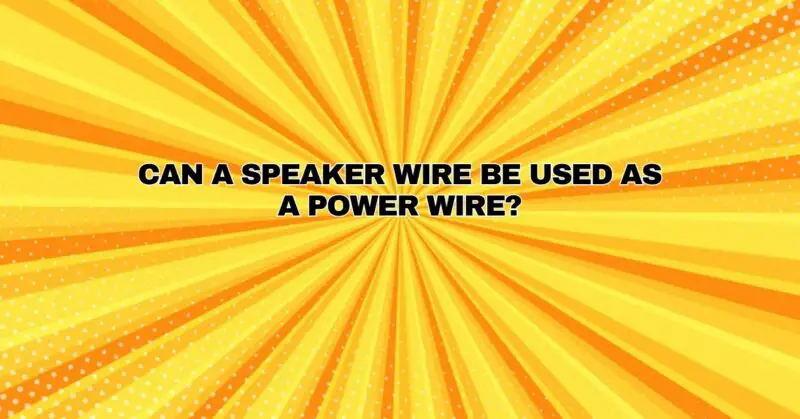Speaker wire and power wire serve distinct purposes in an electrical or audio system. Speaker wire is designed to carry audio signals from an amplifier or receiver to speakers, while power wire is intended to deliver electrical current from a power source (e.g., a battery or power supply) to electrical components like amplifiers, lights, or motors. While it’s possible to use speaker wire as a power wire in some situations, it comes with limitations and considerations that need to be addressed. In this comprehensive guide, we’ll explore the possibilities and limitations of using speaker wire as a power wire and when it may be suitable.
Understanding Speaker Wire and Power Wire
Before delving into using speaker wire as a power wire, it’s important to understand the key differences between the two:
Speaker Wire:
- Designed for transmitting audio signals.
- Typically has two conductors (positive and negative) insulated from each other.
- Conductors are often stranded for flexibility.
- Gauge (thickness) varies based on the power requirements and distance to the speakers.
- Not designed to handle high electrical currents.
Power Wire:
- Designed for carrying electrical current.
- Single or multiple conductors, often with thicker gauge wires.
- Insulation is typically more robust to withstand higher voltages and currents.
- Used to connect power sources (e.g., batteries, power supplies) to electrical components.
- Designed to handle high electrical currents safely.
Using Speaker Wire as a Power Wire: Possibilities
In some low-power and low-voltage applications, using speaker wire as a power wire may be feasible. Here are a few scenarios where it might work:
- Low-Power Lighting: Speaker wire can be used for low-voltage lighting systems, such as LED strip lights or garden lights, where the power requirements are minimal, and safety concerns are limited.
- Audio Amplifiers: In small audio amplifier circuits with low power requirements (e.g., headphone amplifiers), speaker wire can be used to connect the power source to the amplifier. However, this is only suitable for low-power applications.
- DIY Projects: For DIY electronics projects with minimal power needs, using speaker wire to connect components or sensors to a power source can be an option.
Limitations and Considerations
Using speaker wire as a power wire has several limitations and considerations:
- Limited Current Handling: Speaker wire is not designed to handle high electrical currents. Attempting to use it for high-power applications can lead to overheating, voltage drop, and safety hazards.
- Voltage Drop: Over longer cable runs or with higher currents, speaker wire may experience significant voltage drop due to its inherent resistance. This can result in reduced voltage at the load (device), impacting its performance.
- Safety Concerns: Speaker wire lacks the insulation and robustness of dedicated power wires. Using it for high-power applications can pose safety risks, including electrical shocks and fires.
- Regulatory Compliance: Electrical codes and regulations often dictate the use of specific wires for power distribution to ensure safety and compliance. Using speaker wire inappropriately may not meet these requirements.
When Speaker Wire as a Power Wire Might Work
If you’re considering using speaker wire as a power wire, ensure it’s for low-power, low-voltage applications where safety concerns are minimal. Here are some instances when it might work:
- Educational Projects: Speaker wire can be suitable for educational projects, where the focus is on learning electronics basics and low-power experimentation.
- Temporary or Prototyping: In prototyping or temporary setups, using speaker wire to connect low-power components can be a quick and convenient solution.
- Supplemental Power: In some situations, you may use speaker wire alongside dedicated power wires to distribute low-power signals or supplement power to components.
Safety and Caution
Regardless of the application, safety should always be a priority. When using speaker wire as a power wire:
- Ensure Low Power: Only use speaker wire for low-power, low-voltage applications.
- Check Regulations: Familiarize yourself with local electrical codes and regulations to ensure compliance.
- Monitor Heat: If the wire becomes hot during use, disconnect it immediately to prevent overheating.
- Consider Voltage Drop: Be aware of voltage drop issues, especially over longer cable runs.
- Use Adequate Insulation: If using speaker wire for power, ensure that the connections are well-insulated to prevent electrical hazards.
Conclusion: Speaker Wire for Limited Applications
While it’s possible to use speaker wire as a power wire in limited, low-power scenarios, it’s essential to exercise caution and prioritize safety. In most cases, it’s advisable to use dedicated power wires designed to handle higher currents and voltages, particularly for any applications involving significant power requirements. Always follow best practices and applicable regulations to ensure the safety and functionality of your electrical or electronic projects.


